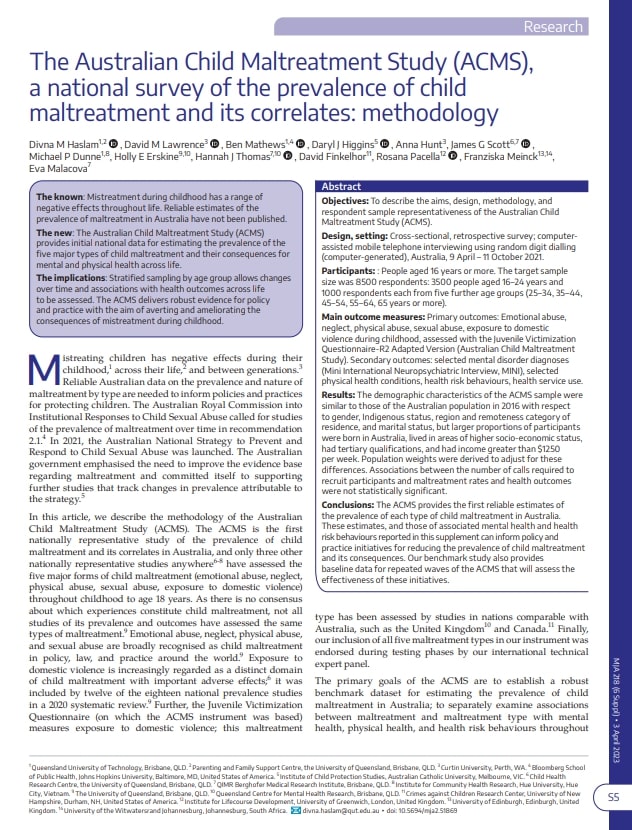Methodology of the Australian Child Maltreatment Study (ACMS): A national survey of the prevalence of child maltreatment and its correlates.
This paper outlines the methodological foundation on which theother ACMS papers build. It outlines the broad methodology, measures, and sample of the ACMS. It was published in the Medical Journal of Australian ACMS Supplement.
Abstract
Objectives: To describe the aims, design, methodology, and respondent sample representativeness of the Australian Child Maltreatment Study (ACMS).
Design, setting: Cross- sectional, retrospective survey; computer assisted mobile telephone interviewing using random digit dialling (computer- generated), Australia, 9 April – 11 October 2021.
Participants: People aged 16 years or more. The target sample size was 8500 respondents: 3500 people aged 16– 24 years and 1000 respondents each from five further age groups (25– 34, 35– 44, 45– 54, 55– 64, 65 years or more).
Main outcome measures: Primary outcomes: Emotional abuse, neglect, physical abuse, sexual abuse, exposure to domestic violence during childhood, assessed with the Juvenile Victimization Questionnaire- R2 Adapted Version (Australian Child Maltreatment Study).
Secondary outcomes: selected mental disorder diagnoses (Mini International Neuropsychiatric Interview, MINI), selected physical health conditions, health risk behaviours, health service use.
Results: The demographic characteristics of the ACMS sample were similar to those of the Australian population in 2016 with respect to gender, Indigenous status, region and remoteness category residence, and marital status, but larger proportions of participants were born in Australia, lived in areas of higher socio- economic status, had tertiary qualifications, and had income greater than $1250 per week. Population weights were derived to adjust for these differences. Associations between the number of calls required to recruit participants and maltreatment rates and health outcomes were not statistically significant.
Conclusions: The ACMS provides the first reliable estimates of the prevalence of each type of child maltreatment in Australia. These estimates, and those of associated mental health and health risk behaviours reported in this supplement can inform policy and practice initiatives for reducing the prevalence of child maltreatment and its consequences. Our benchmark study also provides baseline data for repeated waves of the ACMS that will assess the effectiveness of these initiatives.
Suggested citation
Haslam DM, Lawrence D, Mathews B, Higgins D, Hunt A, Scott JG, Dunne MP, Erskine HE, Thomas HJ, Finkelhor D, Pacella, R, Meinck F, & Malacova E. Methodology of the Australian Child Maltreatment Study (ACMS): A national survey of the prevalence of child maltreatment and its correlates. Med J Aust 2023; 218 (6 Suppl): S5-S12. https://doi.org/10.5694/mja2.51869.
